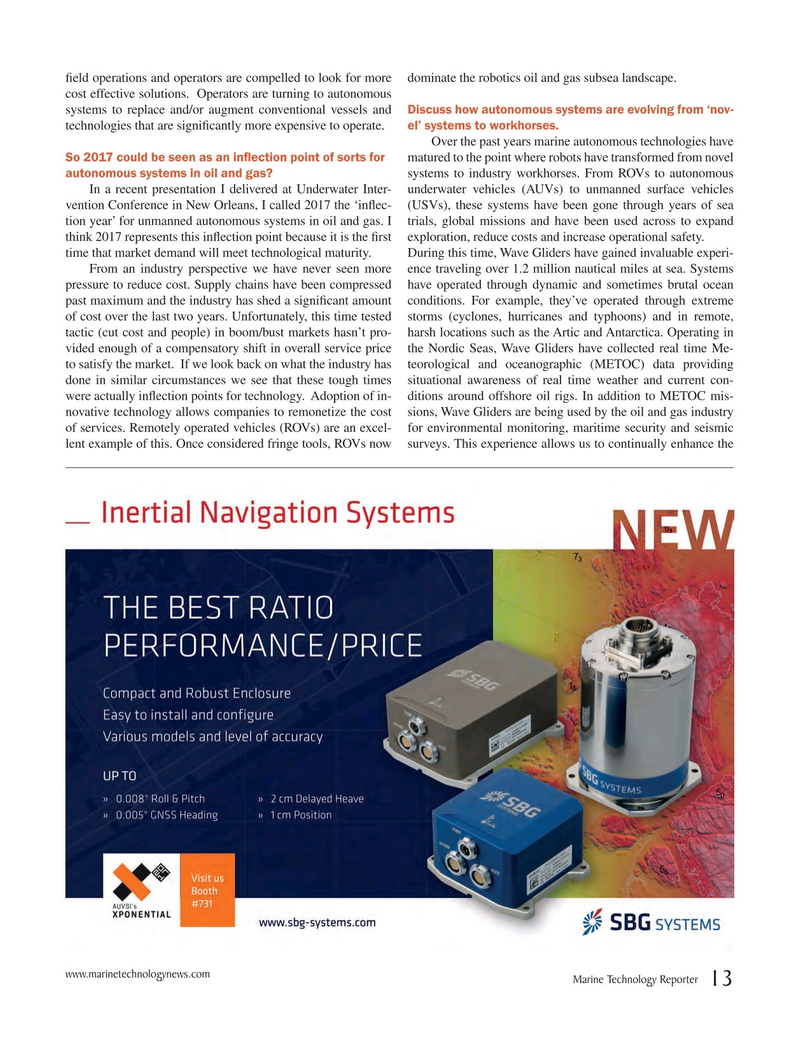
Page 13: of Marine Technology Magazine (April 2017)
Offshore Energy Annual
Read this page in Pdf, Flash or Html5 edition of April 2017 Marine Technology Magazine
? eld operations and operators are compelled to look for more dominate the robotics oil and gas subsea landscape.
cost effective solutions. Operators are turning to autonomous systems to replace and/or augment conventional vessels and Discuss how autonomous systems are evolving from ‘nov- technologies that are signi? cantly more expensive to operate. el’ systems to workhorses.
Over the past years marine autonomous technologies have
So 2017 could be seen as an in? ection point of sorts for matured to the point where robots have transformed from novel autonomous systems in oil and gas? systems to industry workhorses. From ROVs to autonomous In a recent presentation I delivered at Underwater Inter- underwater vehicles (AUVs) to unmanned surface vehicles vention Conference in New Orleans, I called 2017 the ‘in? ec- (USVs), these systems have been gone through years of sea tion year’ for unmanned autonomous systems in oil and gas. I trials, global missions and have been used across to expand think 2017 represents this in? ection point because it is the ? rst exploration, reduce costs and increase operational safety. time that market demand will meet technological maturity. During this time, Wave Gliders have gained invaluable experi- From an industry perspective we have never seen more ence traveling over 1.2 million nautical miles at sea. Systems pressure to reduce cost. Supply chains have been compressed have operated through dynamic and sometimes brutal ocean past maximum and the industry has shed a signi? cant amount conditions. For example, they’ve operated through extreme of cost over the last two years. Unfortunately, this time tested storms (cyclones, hurricanes and typhoons) and in remote, tactic (cut cost and people) in boom/bust markets hasn’t pro- harsh locations such as the Artic and Antarctica. Operating in vided enough of a compensatory shift in overall service price the Nordic Seas, Wave Gliders have collected real time Me- to satisfy the market. If we look back on what the industry has teorological and oceanographic (METOC) data providing done in similar circumstances we see that these tough times situational awareness of real time weather and current con- were actually in? ection points for technology. Adoption of in- ditions around offshore oil rigs. In addition to METOC mis- novative technology allows companies to remonetize the cost sions, Wave Gliders are being used by the oil and gas industry of services. Remotely operated vehicles (ROVs) are an excel- for environmental monitoring, maritime security and seismic lent example of this. Once considered fringe tools, ROVs now surveys. This experience allows us to continually enhance the www.marinetechnologynews.com
Marine Technology Reporter 13
MTR #3 (1-17).indd 13 MTR #3 (1-17).indd 13 3/30/2017 12:36:47 PM3/30/2017 12:36:47 PM

 12
12

 14
14
